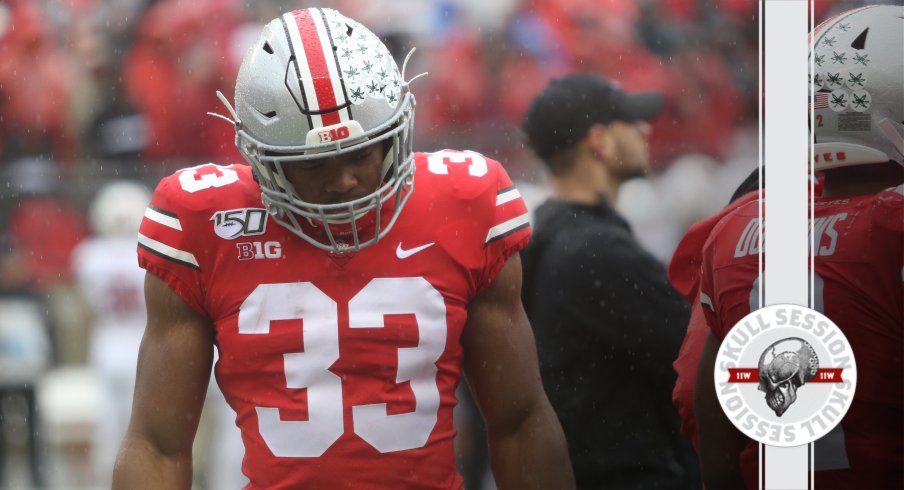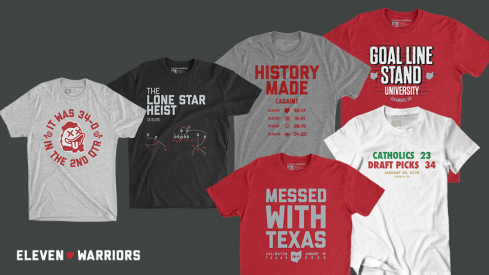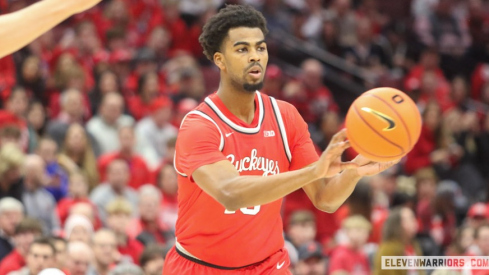Former North Carolina defensive end Beau Atkinson commits to Ohio State.
It is Friday. Congratulations.
Word of the Day: Expurgate.
HANG THE BANNER. Ohio State did not win the elusive golden phallus this year. That shiny spire of joy will live in Baton Rouge with the true and rightful kings of college football after a scorched-earth campaign through some of the nation's best.
LSU deserves its prize, and nobody else has any valid claim to a national title – but that doesn't mean the Tigers were the best team in college football throughout this season. That, according to Bill Connelly's SP+ predictive data, was Ohio State.
I frequently find myself calling predictive ratings "anti-social" because of the way they seem to go out of their way to frustrate people. For college football, they are not intended to name a national champion or derive the quality of your résumé -- they're just intended to predict who would win the most games (and by how much, on average) if everyone played everyone countless times. You probably don't get credit for head-to-head wins, and in a lot of formulas you don't get extra credit for playing particularly well in specific games.
This is a long way of saying that LSU, 2019's national champion and a team that finished the season playing otherworldly ball, didn't finish the year No. 1 in SP+, just as it didn't finish No. 1 in FPI. Ohio State all but clinched the No. 1 spot by playing the best overall ball in the regular season and then playing Clemson to a near-statistical draw in the CFP semifinals.
Oh well. LSU timed its peak perfectly, playing well throughout the year and then going nuclear late. In the Tigers' last four games, their average per-game SP+ percentile rating was 99%. Play like that all year, and you're the greatest team of all time. As it stands, their midseason defensive funk (driven in part by injuries) dragged their full-season numbers down to that of a merely tremendous team.
TL;DR, Ohio State was better on average throughout the entire season, but LSU unstoppable at its peak, and it peaked at the most perfect time possible.
The Buckeyes didn't allow 38 points to Vanderbilt in September – they spent that same day pasting an eventual conference champion 76-5 – but they also didn't slap Clemson around by three scores in a playoff game, either.
So, yes. Given the data we have, Ohio State was the best and most consistently great team in the country. But that doesn't mean jack without a trophy.
“THE GOLD STANDARD.” To the casual observer (or the opinionated blogger), the NCAA has seemed remarkably inconsistent with its handling of immediate eligibility waivers. You've got folks transferring to get closer to dying loved ones that have their waivers coldly and swiftly rejected while guys with seemingly no case are gifted it no problem.
But according to attorney and immediate eligibility guru Tom Mars, it's probably not always that the NCAA is being inconsistent and unreasonable, it's that some schools' compliance departments have no idea what the hell they're doing.
Ohio State's ain't one of them, and that's probably why the process seems to go pretty smoothly in both directions when the Buckeyes are involved.
Mars had successfully “driven a truck through that loophole” of the simple requirement of mitigating circumstances, so the NCAA’s fix last June was to change the wording to “extraordinary, extenuating, mitigating circumstances beyond a student-athlete’s control,” rather than just the phrase “mitigating circumstances” he’d previously exploited.
The additional language made it more difficult to achieve a waiver, though it muddied the waters of who was given waivers and who was not, with little clarity. Student privacy laws prevent the NCAA or universities from commenting on the details of decisions.
It also produced a frustration across the sport for perceived inconsistencies, but Mars says some of that is a product of the compliance offices handling of cases. He pointed to Ohio State as the “gold standard” of compliance offices and said Tennessee’s Andrew Donovan and Adam Tate are “among the best in the business.”
...
“In those cases that I’ve not been involved in, the written advocacy varies from excellent to pathetic. It’s all across the board, and that’s one of the reasons we’re seeing what I prefer to call ‘perceived inconsistencies’ in who gets a waiver,” Mars said. “Often times, the results that appear to be inconsistent decisions aren’t the result of inconsistent decisions by decision makers in Indianapolis. They’re the result of one compliance office doing an excellent job presenting the case on behalf of the student-athlete and the other compliance staff doing a terrible job.”
To me, that would seem to indicate that the entire process is too damn complicated, but what do I know. I guess I'm just glad my favorite sports team has that weird-ass competitive advantage over other programs. Go Bucks?
Also, Mars calling Ohio State's compliance department the "gold standard" is extremely interesting. I'm not sure if he's talking about the department as a whole or just as it relates to waivers, but I wouldn't be shocked if it's just blanket praise.
The narrative around the country is that Ohio State runs a dirty program full of covered-up scandals where everything is swept under a rug. And you know, I totally understand where that perception comes from, even if it's not fair.
But in reality, Ohio State is frustratingly compliant. It's as obnoxious as the kid who reminds the teacher that she was supposed to give the class extra homework just before the bell rings.
Example: LSU just had an alum caught on camera dapping wads of cash into players' hands on the field and the school's initial response was "Oh, it was pretend money," and they probably would have gotten away with it if Joe Burrow didn't admit it was real on a national podcast. Meanwhile, Ohio State caught wind of the fact that its best player took a loan (which he already paid back) from a family friend over a year ago and immediately ran to the NCAA and suggested he be suspended.
If you need more convincing, just take a scroll through Ohio State's self-reported violations from the past two years (one of which included Urban Meyer accidentally responding to a "Happy Father's Day" text) and tell me they shouldn't lie more.
BEST BUCKEYE BUDS. Dick Lebeau and Paul Warfield are life-long friends and competitors, and it all started in physiology class.
Though they met in physiology, the chemistry between @OhioStateFB Buckeye boys Dick Lebeau and Paul Warfield has bonded them for nearly half a century. pic.twitter.com/CcdHQ1FZk8
— NFL Films (@NFLFilms) January 16, 2020
Ohio State: the place where lifetime bonds begin between future Hall of Famers. In 50 years, I guarantee we hear some of these same stories, because I'm absolutely sure the Buckeyes aren't done sending dudes to Canton.
I would love to say I have a similar story, but my name will be nowhere near any hall of fame and I would have actually had to have attended class with any sort of frequency to form a bond with my lab partner.
COMING TO THE LIGHT. Pierre-Luc Dubois wasn't a born Buckeye, but he's been built into one.
ESPN: Also, according to your IG, you've become a bit of a Cleveland Browns fan.
Dubois: Yeah. My mom's American. She's from Atlanta. So growing up, it was Braves and Falcons and the University of Georgia. So it's kind of a mix of, you know, Georgia sports. Then I come to Columbus, and I become a Browns fan and become a Buckeyes fan. Still root for the Braves, though.
Damn, we already have Justin Fields, now Georgia's giving us Dubois too? Thanks, Kirby Smart.
THE SEARCH BEGINS. The search is officially on for Ohio State's next university president, but don't hold your breath on the announcement because it sounds like one hell of a process.
As previously announced, Ohio State Trustee Lewis Von Thaer will serve as chair of the Presidential Search Committee. The committee includes two subcommittees: a Presidential Selection Subcommittee and a University Advisory Subcommittee.
“We are committed to a process that is inclusive and brings together our far-reaching Buckeye community,” Von Thaer said.
The Presidential Selection Subcommittee is composed of trustees who serve as chairs or vice chairs of the board’s regular committee structure: Von Thaer (chair), Alex R. Fischer, Hiroyuki Fujita, Erin P. Hoeflinger, Brent R. Porteus, Abigail S. Wexner and John W. Zeiger. It will work in concert with the University Advisory Subcommittee, manage the use of external search firm Isaacson, Miller and ultimately provide a candidate recommendation to the board.
The 20-member University Advisory Subcommittee is composed of students, faculty, staff and community stakeholders. It will be tasked with representing and seeking input from the broader Ohio State community in order to identify the qualities, skills, attributes and experiences desired in a candidate.
I'll be sure to let you all know when I get the call. I will lead my beloved university with grace, with power, and with Arby's.
NOT STICKING TO SPORTS. Fishermen accidentally catch a secret U.S. Navy microphone planted on the ocean floor... A U.S. Bank employee was fired after helping a broke and stranded man on Christmas Eve... A deaf man sues PornHub over a lack of closed captioning... How the Navy SEALs wound up buying 450 counterfeit radio antennas... A chemical plant explosion launches a metal plate into the air, killing a man two miles away... The tug of war over Notre Dame's transformation.


